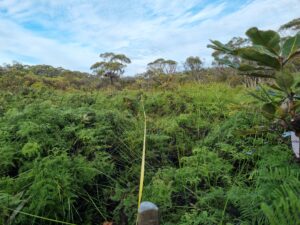
Vegetation Monitoring
Client: Wollongong Resources Pty Ltd
Location: Metropolitan special area
Date: 2010, ongoing
Services provided
- Preparation of biodiversity assessments to support Review of Environmental Factors and Environmental Impact Statements
- Preparation of management plans
- Baseline mapping to determine Coastal Upland Swamp extents
- Targeted flora and fauna surveys
- Interim and annual flora, fauna and aquatic monitoring reports
Background
Wollongong Resources Pty Ltd operates the Russell Vale Colliery located in the Southern Coalfield of New South Wales. To examine the impacts to Coastal Upland Swamps and threatened species associated with the Russell Vale Underground Expansion Project , Biosis has developed and implemented several long-term ecological monitoring programs within the area.
These programs involve the bi-annual seasonal collection of floristic data using before-after-control-impact (BACI) design and analysis of the key biodiversity indicators, such as floristic diversity and abundance, to determine change in key indicator species. The bi-annual monitoring also includes fauna (such as Giant Dragonfly and Giant Burrowing Frog) and aquatic macroinvertebrates, to assess the impact of mining on threatened species and waterways.
In addition, Biosis has provided Wollongong Resources Pty Ltd with continuous environmental consulting services over the past 13 years with scope to prepare; biodiversity assessments to support the development application for the Underground Expansion Project, Wongawilli mine State and Federal approval, public environment reports, Review of Environmental Factors for installation of monitoring equipment, Biodiversity Management Plans, Upland Swamp Management Plans, and Surface Facilities Management Plan for the Russell Vale East Underground Expansion Project. Targeted surveys have also been undertaken by Biosis for a range of threatened flora and fauna to support the projects.
Outcome
Wollongong Resources Pty Ltd and regulatory authorities have placed a high priority on ensuring that the Underground Expansion Project minimises impacts on biodiversity. Biosis worked closely with project partners and stakeholder groups throughout the development application process by providing independent and expert ecological advice and establishing rigorous monitoring programs.
The long-term vegetation monitoring program involves data management and statistical analyses of significant volumes of ecological data (collected over more than 10 years), in addition to spatial analysis to provide high quality ecological reports. These projects demonstrate Biosis’ ability to collect, manage and analyse detailed and long-term floristic data for large scale projects.
Refined modelling has allowed Biosis to discriminate between vegetation communities based on canopy height, topographic location, percent foliage cover and landscape features, including flow accumulation modelling and geology/soils landscape data.
This method has helped to identify areas of extent changes in vegetation, define vegetation formations, and quickly validate and change plant community type boundaries using Geographic Information System enabled tablets and real-time capture methods. The methods developed and implemented have enabled Biosis to monitor for subsidence-related impacts from mining in relation to the Underground Expansion Project.
